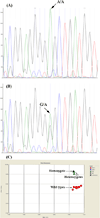A discriminative analytical method for detection of CES1A1 and CES1A2/CES1A3 genetic variants
- PMID: 22237548
- PMCID: PMC3412537
- DOI: 10.1097/FPC.0b013e32834f03eb
A discriminative analytical method for detection of CES1A1 and CES1A2/CES1A3 genetic variants
Abstract
Human carboxylesterase 1 (hCES1), encoded by the CES1 gene, is the predominant hepatic hydrolase responsible for the metabolism of many therapeutic agents, toxins, and endogenous substances. Genetic variants of CES1 can affect hCES1 function and expression and ultimately influence clinical response to drugs serving as hCES1 substrates. The CES1 gene consists of three isoforms including the functional CES1A1 and CES1A2 genes and the nonfunctional pseudogene CES1A3. Natural variants of these isoforms exert differing impacts on hCES1 function. However, the existing CES1 genotyping methods are incapable of determining whether these variants belong to CES1A1, CES1A2, or CES1A3 because of the high similarity among these three genes, as a consequence they are unable to discriminate between heterozygotes and homozygotes. We report the development of a novel long-range PCR-based, discriminative genotyping assay capable of specifically detecting the variants among CES1A1, CES1A2, and CES1A3 genes. The comparison of the genotyping results between this novel assay and those previously reported methods highlighted the necessity of applying the discriminative genotyping assay in pharmacogenetic studies involving CES1 gene.
Conflict of interest statement
No conflicts of interest to disclose.
Figures


References
-
- Imai T, Taketani M, Shii M, Hosokawa M, Chiba K. Substrate specificity of carboxylesterase isozymes and their contribution to hydrolase activity in human liver and small intestine. Drug Metab Dispos. 2006;34:1734–1741. - PubMed
-
- Hosokawa M, Furihata T, Yaginuma Y, et al. Structural organization and characterization of the regulatory element of the human carboxylesterase (CES1A1 and CES1A2) genes. Drug Metab Pharmacokinet. 2008;23:73–84. - PubMed
-
- Hosokawa M, Furihata T, Yaginuma Y, et al. Genomic structure and transcriptional regulation of the rat, mouse, and human carboxylesterase genes. Drug Metab Rev. 2007;39:1–15. - PubMed
-
- Fukami T, Nakajima M, Maruichi T, et al. Structure and characterization of human carboxylesterase 1A1, 1A2, and 1A3 genes. Pharmacogenet Genomics. 2008;18:911–920. - PubMed
Publication types
MeSH terms
Substances
Grants and funding
LinkOut - more resources
Full Text Sources
Miscellaneous

